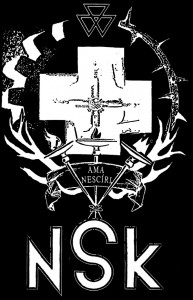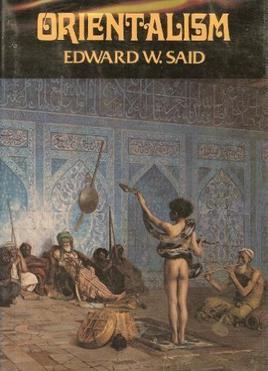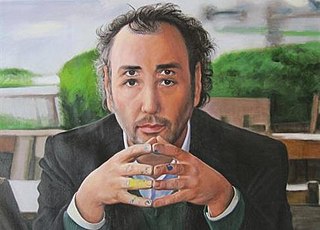
In the arts and in literature, the term avant-garde identifies a genre of art, an experimental work of art, and the experimental artist who created the work of art, which usually is aesthetically innovative, whilst initially being ideologically unacceptable to the artistic establishment of the time. The military metaphor of an advance guard identifies the artists and writers whose innovations in style, form, and subject-matter challenge the artistic and aesthetic validity of the established forms of art and the literary traditions of their time; thus how the artists who created the anti-novel and Surrealism were ahead of their times.

Neue Slowenische Kunst is a political art collective that formed in Slovenia in 1984, when the Socialist Republic of Slovenia was part of Socialist Federal Republic of Yugoslavia. NSK's name was chosen to reflect the theme in its works of the complicated relationship Slovenes have had with Germans. The name of NSK's music wing, Laibach, is also the German name of the Slovene capital Ljubljana. The name created controversy because some felt it evoked memories of the Nazi annexation of Slovenia during the Second World War. It also refers to Slovenia's previous seven centuries as part of the Habsburg monarchy.
In the minds of many foreigners, Slovenian folk music means a form of polka that is still popular today, especially among expatriates and their descendants. However, there are many styles of Slovenian folk music beyond polka and waltz. Kolo, lender, štajeriš, mafrine and šaltin are a few of the traditional music styles and dances.
net.art refers to a group of artists who have worked in the medium of Internet art since 1994. Some of the early adopters and main members of this movement include Vuk Ćosić, Jodi.org, Alexei Shulgin, Olia Lialina, Heath Bunting, Daniel García Andújar, and Rachel Baker. Although this group was formed as a parody of avant garde movements by writers such as Tilman Baumgärtel, Josephine Bosma, Hans Dieter Huber and Pit Schultz, their individual works have little in common.
IRWIN is a collective of Slovenian artists, primarily painters, and an original founding member of Neue Slowenische Kunst (NSK).

Orientalism is a 1978 book by Edward W. Said, in which the author establishes the term "Orientalism" as a critical concept to describe the West's commonly contemptuous depiction and portrayal of The East, i.e. the Orient. Societies and peoples of the Orient are those who inhabit the places of Asia, North Africa, and the Middle East. Said argues that Orientalism, in the sense of the Western scholarship about the Eastern World, is inextricably tied to the imperialist societies who produced it, which makes much Orientalist work inherently political and servile to power.

Walid Raad (Ra'ad) (Arabic: وليد رعد) (born 1967 in Chbanieh, Lebanon) is a contemporary media artist. The Atlas Group is a fictional collective, the work of which is produced by Walid Raad. He lives and works in New York, where he is currently a distinguished visiting professor of photography at Bard College, in addition to being a professor of photography at the Cooper Union School of Art.
Rhizome is an American not-for-profit arts organization that supports and provides a platform for new media art.

Teo Spiller is a Slovenian digital artist who has been active in the net.art movement since 1995. Spiller is notable for being one of the first artists to sell a piece of Internet art to a museum or collector. As of March 2018 he was an assistant professor at Arthouse College in Ljubljana.
Afterall is a nonprofit contemporary art research and publishing organisation. It is based in London, at Central St Martins College of Art & Design. It publishes the journal Afterall; the book series Readers,One Works and Exhibition Histories.

Zdenka Badovinac is a curator and writer, was the director of the Museum of Contemporary Art Zagreb, Croatia. She served between 1993 and 2021 as director of the Museum of Modern Art in Ljubljana, comprised since 2011 of two locations: the Museum of Modern Art and the Metelkova Museum of Contemporary Art in Metelkova, an autonomous art, culture, and social center in Ljubljana. In 2022, she was appointed director of the Museum of Contemporary Art in Zagreb. She resigned from her position in the fall of 2023 due to personal reasons. She returned to Ljubljana, where she currently works as an independent curator, author and international consultan
Ștefan Constantinescu,, is a Swedish-Romanian visual artist and film director living and working in Stockholm. He works with various mediums including film, artist books and paintings approaching the political through introspection to challenge notions of identity, while working in and with issues of post-communist Romania. Constantinescu grew up in Romania during the most austere years of communism, where an ordinary day began with a queue for almost anything - days of routine. As a result, his work is often strongly autobiographical. Within the work, monuments are challenged as permanent inscriptions of memory, fictional films resemble unofficial documentaries, and artist books challenge history and education. Known for his "powerful study of everyday terror" in his short film Troleibuzul 92 that was shown in the Venice Biennale 2009

Genco Gülan is a contemporary conceptual artist and theorist, who lives and works in Istanbul. His transmedia contextual work involves painting, found objects, new media, drawings, sculpture, photography, performance and video. His work often carries political, social and/or cultural messages; mainly describing his work as idea art.
Angela Washko is an American new media artist and facilitator based in New York. She is currently associate professor of art at Carnegie Mellon University. Washko mobilizes communities and creates new forums for discussions of feminism where they do not exist.
e-flux is a publishing platform and archive, artist project, curatorial platform, and e-mail service founded in 1998. The arts news digests, events, exhibitions, schools, journal, books, and art projects produced and/or disseminated by e-flux describe strains of critical discourse surrounding contemporary art, culture, and theory internationally. Its monthly publication, e-flux journal, has produced essays commissioned since 2008 about cultural, political, and structural paradigms that inform contemporary artistic production.

Galit Eilat, born 1965 in Israel, is an independent curator and writer living in the Netherlands.
Kathy Rae Huffman is an American curator, writer, producer, researcher, lecturer and expert for video and media art. Since the early 1980s, Huffman is said to have helped establish video and new media art, online and interactive art, installation and performance art in the visual arts world. She has curated, written about, and coordinated events for numerous international art institutes, consulted and juried for festivals and alternative arts organisations. Huffman not only introduced video and digital computer art to museum exhibitions, she also pioneered tirelessly to bring television channels and video artists together, in order to show video artworks on TV. From the early 1990s until 2014, Huffman was based in Europe, and embraced early net art and interactive online environments, a curatorial practice that continues. In 1997, she co-founded the Faces mailing list and online community for women working with art, gender and technology. Till today, Huffman is working in the US, in Canada and in Europe.
Zach Blas is an artist and writer based in London. His work engages technology and politics and has been exhibited internationally at venues including IMA Brisbane; Museo Universitario Arte Contemporáneo, Mexico City; Whitechapel Gallery, London; and ZKM Center for Art and Media Karlsruhe. Currently, Blas is a lecturer in the department of Visual Cultures at Goldsmiths.
iLiana Fokianaki is a Greek curator, writer, theorist, educator and former journalist based in Athens and Rotterdam.








